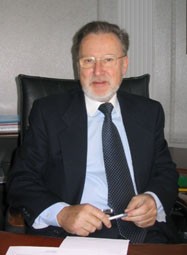Personal tools
News from ICTP 113 - What's New

ICTP has forged a new partnership with the Central European Initiative (CEI) to strengthen the Centre's ties with some of its closest scientific neighbours.
Going East
ICTP's global reputation has
been built on its contributions to the advancement of science,
mainly in the South. Nevertheless, nurturing ties with its scientific
neighbours in eastern and central Europe has always been a key
aspect of the Centre's overall agenda.
Indeed over the past 40 years, no fewer than 14,000 scientists
from eastern and central Europe have participated in ICTP research
and training activities.
That's why it should come as no surprise to learn that ICTP has
recently forged a partnership with the Central European Initiative
(CEI) to help advance that region's scientific capabilities.
"CEI," explains Ambassador Harald W. Kreid, an Austrian
diplomat who serves as the organisation's director general, "was
created in November 1989 through an agreement between Austria,
Hungary, Italy and the former Yugoslavia."

Harald Kreid
Today the organisation has 17 member states. The Italian government
provides most of its funding and the secretariat is located in
Trieste.
"CEI's 'founding' purpose," Kreid says, "was to
promote a dialogue between systems and ideologies that usually
viewed each other with suspicion and hostility."
But two days after the official formation of CEI, the Berlin Wall
fell. A European continent that had been split in two for nearly
half a century had become one again. As a result, CEI quickly
refocussed its mandate from one based on 'dialogue' to one based
on 'action.'
During the organisation's first decade of existence, CEI largely
funded 'feasibility studies' designed to outline potential projects
for building and improving small- and medium-sized enterprises,
agricultural cooperatives and other institutional structures that
would help determine the success of the new political and economic
order.
"CEI," Kreid notes, "wanted to help provide a strategic
framework for critical investments among our member states."
According to a recent study, the 4 million euro that CEI spent
on these initiatives ultimately generated some 50 million euro
in bank loans.
"Once those activities were underway, we began to focus directly
on improving the region's overall infrastructure," says Kreid.
"CEI is not a large organisation and therefore we have funded
relatively small projects to upgrade, for example, local transportation
and communication systems and to increase the reliability of local
power networks. We have invested our limited funds in ways designed
to leverage much larger investments from other organisations,
including the European Commission."
"More recently," Kreid notes, "CEI has expanded
its efforts to the role that knowledge---and particularly the
mobility of knowledge---will undoubtedly play in the region's
future well-being."
That's why the organisation has now turned to ICTP and the other
international scientific institutions that belong to the Trieste
System. "We are fortunate to have such a bright constellation
of scientific institutions as our neighbours," observes Kreid.
"We believe these institutions could help us attain our future
goals."
To date, CEI has signed an agreement with ICTP that enables scientists
from CEI member states to participate in ICTP workshops and conferences
devoted, for example, to wireless communication, photonics and
optics, and plasma physics.
The International Centre for Genetic Engineering and Biotechnology
(ICGEB), Elettra Synchrotron Light Laboratory and International
Centre for Science and High Technology (ICS), all located in Trieste,
have signed similar agreements, leading to a steady stream of
young scientists visiting the city from Bulgaria, Macedonia, Poland,
and other nations across eastern and central Europe.
CEI's interaction with Trieste's international scientific institutions---largely
through sponsoring the participation of scientists from member
states in research and training activities held in Trieste---represents
CEI's 'primary' science and technology network.
Now that the primary network is up-and-running, each Trieste-based
scientific institution has been asked to forge contacts directly
with scientific institutions in CEI member states. These arrangements
will represent the 'secondary' network in the strategy.
As a first step towards this effort, ICTP will soon sign a memorandum
of understanding with the Belarus Ministry of Education to build
networks in material science and high energy physics and with
the Romanian Academy of Science to forge networks in photonics
and nuclear physics.
"These initial steps," adds Gallieno Denardo, long-time
ICTP staff scientist and the Centre's contact person for the CEI-ICTP
cooperative programme, "hold great promise for future collaboration.
The nations of eastern and central Europe enjoy strong traditions
of scientific excellence. For them, the networks should provide
valuable opportunities to work in international settings that
can take full advantage of their skills and talents."
"For ICTP," Denardo adds, "the programme offers
a chance to build true partnerships with high-level scientists.
It also improves the prospects for having our scientific neighbours
work with us in efforts to assist our colleagues from the South."
In other words, by going East, ICTP hopes that its focus on the
South could ultimately be strengthened. The success of this initiative
will provide yet another measure of the Centre's long-standing
efforts to improve science across the globe through mutual cooperation
and exchange.